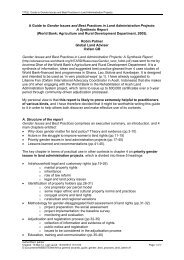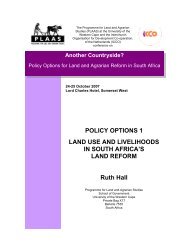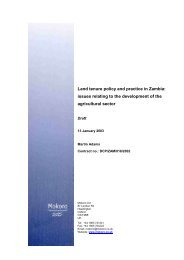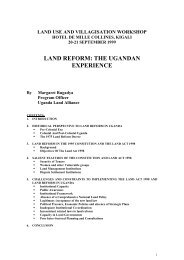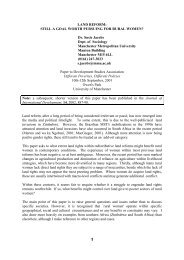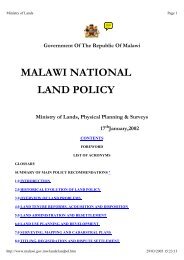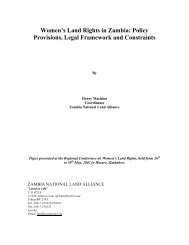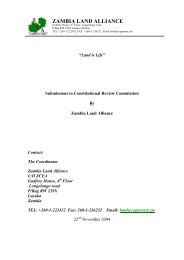The 1999 Land Act and Village Land Act - Mokoro
The 1999 Land Act and Village Land Act - Mokoro
The 1999 Land Act and Village Land Act - Mokoro
Create successful ePaper yourself
Turn your PDF publications into a flip-book with our unique Google optimized e-Paper software.
<strong>The</strong> <strong>1999</strong> <strong>L<strong>and</strong></strong> <strong>Act</strong> <strong>and</strong> <strong>Village</strong> <strong>L<strong>and</strong></strong> <strong>Act</strong> 10<strong>The</strong> case of derivative rights justifies some elaboration. <strong>The</strong> <strong>Act</strong> defines a derivative right as “aright to occupy <strong>and</strong> use l<strong>and</strong> created out of a right of occupancy”, including any form of lease orsub-lease (s. 1). It appears from the <strong>Act</strong> that as soon as you “do” anything to the l<strong>and</strong>, i.e. sell itor lease it, it becomes a derivative right. Meaning that customary rights of occupancy can’t besold or leased, except as rights derived from the “original” customary right. Nevertheless, thegranting (by the <strong>Village</strong> council) or selling (by the holder of a customary right of occupancy or aderivative right) of derivative rights, which constitute more than a ten-year lease or a smallmortgage, invokes a lengthy administrative procedure (see ss. 31-33). An application has to besubmitted on a prescribed form to the <strong>Village</strong> Council. <strong>The</strong> Council shall consider, inter alia, thegrantee or buyer’s ability to use the l<strong>and</strong> for the benefit of the village, the rights of women, <strong>and</strong>the availability of l<strong>and</strong> for the village’s future needs. <strong>The</strong> procedure is very similar to the processof granting customary rights of occupancy, including the setting of fees, rent <strong>and</strong> developmentconditions. <strong>The</strong>re is, however, an added dimension to the case of derivative rights.Derivative rights are divided into three categories according to hectarage. Rights for l<strong>and</strong> lessthat 5 hectares classify as Class A. <strong>L<strong>and</strong></strong> between 5 <strong>and</strong> 30 hectares are Class B, <strong>and</strong> l<strong>and</strong> ofmore than 30 hectares is graded as Class C. For Class A, only the approval of the <strong>Village</strong>Council is required. Class B requires the additional approval of the <strong>Village</strong> Assembly. Grants orsales of Class C require the approval of the <strong>Village</strong> Assembly <strong>and</strong> the “advice” of theCommissioner (s. 32).<strong>The</strong> following sections (ss. 34-47) provide a detailed list of provisions relating to the duties ofthe holder of rights, revocation, foreclosure, passing on rights to next of kin, breach ofconditions, fines <strong>and</strong> remedies for breach of conditions, appeals, etc. Each type of action orprocess is laid down in detail, down to the stipulated mode of consultation, maximum timeallowed for processing <strong>and</strong> what form to fill in. One may justifiably wonder how any village canbe expected to comply with this law, <strong>and</strong> how the law might be expected to assist Tanzania’svillages to administer their l<strong>and</strong> in a manner that is consistent with the principles of sound l<strong>and</strong>management <strong>and</strong> justice.In section 48 we find that, except where “boundaries in l<strong>and</strong> are fully accepted <strong>and</strong> agreed to”,no grant of customary occupancy shall be made until the l<strong>and</strong> has been adjudicated according tothe provisions laid out in Sub-Part C, Part IV of the <strong>Village</strong> <strong>L<strong>and</strong></strong> <strong>Act</strong> (ss. 48-59). 10 <strong>The</strong>re aretwo main alternatives. Either the person applying to register a customary right of occupancy mayapply to the <strong>Village</strong> Council for “spot-adjudication” on a prescribed form (s. 49). If the <strong>Village</strong>Council is satisfied that it will not be necessary to first adjudicate the larger area contiguous tothe l<strong>and</strong> in question, it may approve the application. In which case it may proceed to the processof adjudication (see below). If the <strong>Village</strong> Council rules that a more comprehensive process ofadjudication is required, it needs to submit its decision to the <strong>Village</strong> Assembly for approval. <strong>The</strong><strong>Village</strong> Council is also required to inform the District Council of its decision. If the <strong>Village</strong>Assembly rejects the <strong>Village</strong> Council’s recommendation, the <strong>Village</strong> Council shall inform theDistrict Council. At this stage, the District Council may order the <strong>Village</strong> Council to proceedwith spot-adjudication.When the <strong>Village</strong> Assembly has approved adjudication, a process of “village adjudication” maybegin. First, the <strong>Village</strong> Council appoints a villager with good knowledge of the issues at h<strong>and</strong>,10 This notwithst<strong>and</strong>ing, there are no references to these provisions in the sections dealing with first-time grant ofcertificates of customary rights of occupancy discussed earlier.




